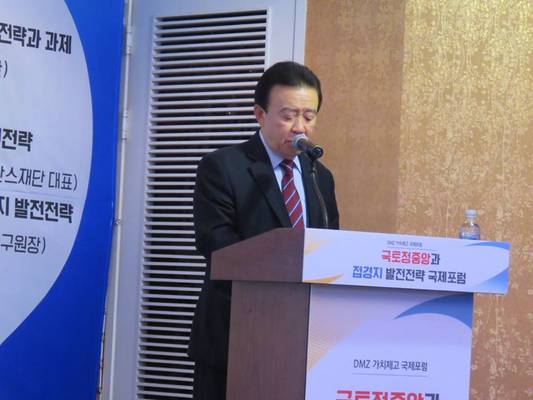International Forum for Raising the DMZ Value in Yanggu, Gangwon Province
Jeon Changbeom, County chief of Yanggu, opening the conference
Now, in Yanggu county in Gangwon province, the “International forum for Raising the DMZ Value” convened to discuss the peaceful and prosperous development of the border area. The forum was opened by Jeon Chang-Beom, the county chief of Yanggu. He was followed by Kim Jung-Seok, CEO of the Kangwon Domin Ilbo, a regional newspaper, organizer of the forum. Lee Jeong-Seok, former unification minister under Kim Dae-Jung, who experienced the period of relatively good North-South relations under the sunshine policy era, gave a keynote speech. In this time of tensions between North and South he reminded people of the value of peace and the fact that modern warfare would leaving both sides of the border even in case of a victory in a North-South conflict deeply harmed, rendering this victory meaningless.
The first presentation was given by Dr. Bernhard Seliger of Hanns Seidel Foundation Korea, which has a long partnership in the border region for sustainable development, starting with Goseong in 2005 and Gangwon province in 2007. He looked back at German experiences of development of the border area and highlighted the importance of a balance of human and natural development in the area. The transformation of the former “death strip”, as the border was called due to countless East Germans killed here while attempting to flee to the West, to a “strip of life”, hosting the largest European biosphere system linking landscape protection areas, nature protection areas, biosphere reserves, natural parks and national parks along the more than 1300 km of the former inner-German border, completely changed the image of the area. Bicycle tourism, walking ways, cultural and historic memorials are integral part of the new border experience. At the same time, the regional and local solutions mean that no unnecessary burden was put on necessary reconnection of transportation and industrial development in the border area. Regions, which since the 1970s went through a long decline, like in Upper Franconia, experienced another decline after a short “unification boom”, but finally in the last ten years earned the fruits of transformation and the former border area today is again a pulsating economic region in the heart of Europe.
The second presentation was given by Dr. Kim Yeongbong, President of the Center for Korean Prosperity, who as a regional planner was for more than two decades involved in development of the border area. He asked the audience to understand the inner-Korean border area not as a neglected area, but as an area full of confidence and characterized by its own assets, in particular nature. From this starting point, he developed ideas for a better future of the area.
Finally, a discussion was held with all participants, moderated by Dr. Son Gi-Woong, president of the Korean Institute for National Unification.

